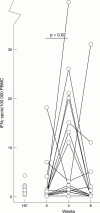Increased peripheral T cell reactivity to microbial antigens and collagen type II in rheumatoid arthritis after treatment with soluble TNFalpha receptors
- PMID: 11156546
- PMCID: PMC1753474
- DOI: 10.1136/ard.60.2.133
Increased peripheral T cell reactivity to microbial antigens and collagen type II in rheumatoid arthritis after treatment with soluble TNFalpha receptors
Abstract
Objective: Peripheral T cells from patients with rheumatoid arthritis (RA) are hyporesponsive when stimulated with antigen or mitogen in vitro, possibly owing to increased production of proinflammatory cytokines such as tumour necrosis factor alpha (TNFalpha). This study sought to find out if and how RA T cell reactivity is affected during treatment with etanercept (Enbrel), a soluble TNFalpha receptor.
Methods: Heparinised blood was collected from patients with RA at baseline, after four and eight weeks of etanercept treatment, and from healthy controls. After density separation spontaneous production of interferon gamma (IFNgamma), TNFalpha, interleukin 6 (IL6), and IL10 by peripheral blood mononuclear cells (PBMC) was detected by ELISPOT. For detection of T cell reactivity, PBMC were stimulated in vitro with mitogen (phytohaemagglutinin (PHA)), microbial antigens (purified protein derivative (PPD), influenza), or an autoantigen, collagen type II (CII). Supernatants were analysed for IFNgamma and IL2 content by enzyme linked immunosorbent assay (ELISA).
Results: In RA the number of cells spontaneously producing IFNgamma was significantly increased after four, but not eight weeks' treatment with etanercept. T cell reactivity, as measured by IFNgamma production to PPD, influenza, and CII was significantly increased after four and sustained after eight weeks' treatment, whereas IFNgamma production induced by PHA remained unchanged. TNFalpha production was significantly higher in patients with RA than in controls and did not change during etanercept treatment.
Conclusion: Treatment of patients with RA with etanercept may lead to increased peripheral T cell reactivity both to microbial antigens and to self antigens such as CII. These findings indicate that TNFalpha blockade may not only suppress but also stimulate certain aspects of antimicrobial immune defence and autoimmunity.
Figures



References
Publication types
MeSH terms
Substances
LinkOut - more resources
Full Text Sources
Medical

